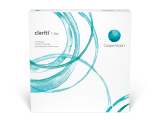Intuitively, it is understood that someone who wears both spectacles and contact lenses is worth more to an optometric practice than a patient who uses only one of those forms of vision correction. Expanding that ‘dual wearer’ opportunity is a fantastic way of delighting patients and growing a practice’s overall business.
Given that contact lenses are designed to be pretty much invisible, it is not surprising that they can be challenging to promote in the office. It is much harder to display contact lenses compared to a range of designer spectacle frames. The lack of visibility is just one example of how easy it becomes to let the option of also correcting vision with contact lenses as well as with spectacles slip from the conversation.
Added to this is the gap in communication which goes something like this:

Moving beyond those patients who are interested in contact lenses but do not ask, there is yet a further group to consider. Those who are open to trying them, but have never seen them as a relevant option. This is understandable too: how do you know if you like something if you have never tried it? The saying “you don’t know what you don’t know” perfectly describes the situation with patients who have never had the opportunity to be exposed to the benefits of contact lenses.
Increasing your ‘Dual Wearers’
Fundamentally, the way to increase the numbers of ‘dual wearers’ in your practice is very simple - routinely recommend contact lenses to all your suitable patients – which will be the majority of them! With wide availability of modern frequently replaced contact lenses, the proportion of patients who have both a suitable refraction and a healthy ocular surface for contact lens wear is extremely high. This makes it possible to recommend lenses to the vast majority of patients. Dual wearers may continue to enjoy wearing their spectacles, making part time contact lens wear often in daily disposable lenses, an excellent, flexible option.
This proactive approach requires contact lenses to be discussed in the office at routine visits. Just mentioning contact lenses as an option for vision correction increases the number of patients trialing and purchasing lenses.1 However, there are a number of tips to help drive growth in dual wearers even further:
Make a professional recommendation
Never underestimate the power of a recommendation from the eye care professional. Remember the significant proportion of patients who are waiting to hear just that. With a couple of simple phrases, a passing mention of contact lenses turns into a compelling professional recommendation. “Your eyes are likely to be suitable for contact lenses, which means you can consider using both spectacles and contact lenses to correct your vision” or “Have you ever considered wearing contact lenses? Your eyes should be perfect for the many options now available”.
Get lenses on eyes
Naturally, one of the main concerns held by someone who has never tried contact lenses is the unknown element of how the lens will feel on the eye. This fear can certainly be enough to prevent someone asking about contact lenses. A delay between suggesting contacts and returning for a trial appointment on a different day allows those concerns to build. The simple solution is to offer a contact lens experience on the same day, removing the chance for fears to grow and enabling the patient to gain immediate insight into what it is like to see the world through contact lenses. Once the seed is planted, it takes just a few minutes to reach for a diagnostic lens and place it gently on the eye for the patient to experience just how comfortable modern lenses can be.
Remove the decision about becoming a contact lens wearer
The simple question of “do you want to try contact lenses?” can actually put a patient on the spot. If they have never considered them before, from nowhere, they are now having to ‘decide’ if they want to become a contact lens wearer. How can they answer this question? They do not know how contact lenses feel; they do not know how lenses may enhance certain aspects of their life. Given these unknowns, it is much easier to respond with a simple “no” to this question. The result being that the conversation is shut down before it even gets going. One way of opening the conversation is to ask if there are any times where the patient would prefer not to be wearing spectacles. This enables them to think of specific situations and activities where contact lenses may be beneficial. In addition to this question, an approach has been demonstrated, the details of which are outlined below.
Contact lenses to aid spectacle frame selection
When these three tips are combined, the advice is to recommend contact lenses, allowing the patient to experience them straight away, all without asking the patient to make an early decision about becoming a wearer. How can this be achieved in clinical practice? A simple approach has been demonstrated and proven in two studies, one based in the UK and one in the US:
Contact lenses are suggested as an aid to spectacle frame selection.
There are several assumed advantages to this approach: the patient gains both a contact lens experience along with improved vision to help with new frame selection. The experience with contact lenses happens immediately, and at no point until after they have tried them does the patient have to consider if they want to proceed with contact lenses.
Results
In total, across the two studies, 257 patients were offered contact lenses to help with frame selection. Nearly two-thirds of patients agreed to try contact lenses in the US study (63%), with nearly nine in ten patients accepting contact lenses to help with frame selection in the UK group (88%).
The results of both studies showed positive outcomes all round: patients spent significantly more on their spectacles2,3, reported higher levels of satisfaction with their dispensing experience2,3, were more likely to schedule a full contact lens fit3 and purchase contact lenses2, compared to controls who were not given such a fabulous opportunity.
Summary
Proactive recommendation of contact lenses will create more dual wearers, which are far more valuable to a business. Offering contact lenses to help with spectacle frame selection provides a mechanism for an instant contact lens wear experience, along with enhancing patient satisfaction with the spectacle dispensing process and increasing the value of the spectacle sale. Literally a win-win for all concerned!
References
Jones L, Jones D, Langley C, Houlford M. Reactive or proactive contact lens fitting - does it make a difference? J Brit Contact Lens Assoc. 1996;19(2):41-43.
Atkins NP, Morgan SL, Morgan PB. Enhancing the approach to selecting eyewear (EASE): a multi-centre, practice-based study into the effect of applying contact lenses prior to spectacle dispensing. Contact Lens & Anterior Eye. 2009;32(3):103-107.
Mayers M, Jansen Bishop M, Walerius D, et al. Improving your spectacle patients' in-practice experience with contact lenses during frame selection. Contact Lens & Anterior Eye. 2019;42(4):406-410.








